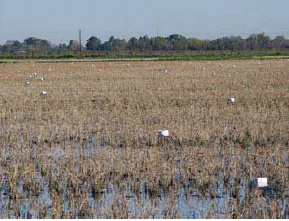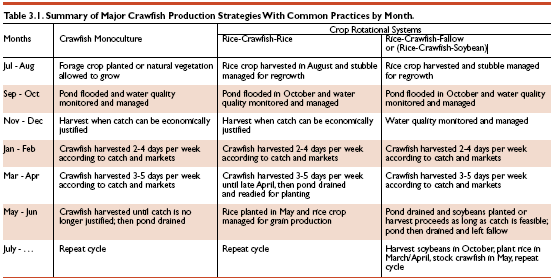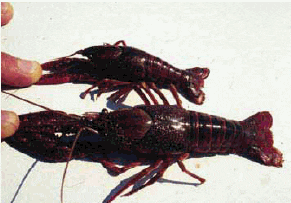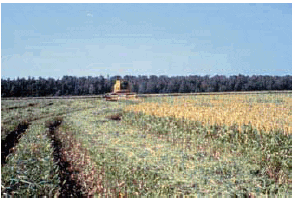
Red swamp and white river crawfish are naturally adapted to habitats with seasonal flooding and drying, where the dry period usually occurs from summer into autumn. The life cycle of crawfish is well suited to fluctuating periods of flooding and dewatering. In their natural, river or swamp habitats, sustained periods of river overflow permit crawfish to feed, grow and mature. Temporary dewatering, in both natural habitats and crawfish ponds, promotes aeration of bottom sediments, reduces abundance of aquatic predators and allows for establishment of vegetation that serves as cover for crawfish and the source of important food resources when water returns. Crawfish survive the dry intervals by digging or retreating to burrows where they can avoid predators, acquire moisture necessary for survival and reproduce in safety.

Current farming practices are based on the annual water cycles and conditions to which these crawfish have become adapted over millions of years. Flooding and draining of crawfish ponds mimic the natural flooding and drying cycle in Louisiana’s Atchafalaya River basin. The control achieved under farming conditions provides optimal timing of these events and allows crawfish producers to positively influence water quality, food resources and other factors within their ponds. As with natural ecosystems, crawfish aquaculture relies on natural reproduction. No hatcheries or nurseries are required. Crawfish in forage-based culture ponds, as in the wild, depend on a naturally available food web for nourishment. Supplemental feeding is not a common practice; it has not yet been shown to predictably increase yields or size of crawfish at harvest.
Crawfish are grown in shallow earthen ponds 8 to 24 inches deep. Relatively flat, easily drained land, with suitable levees, is required for production, harvesting and management of vegetation (Figure 1). Crawfish are cultured in areas where the soil has sufficient clay to hold water and accommodate burrow construction. Water requirements for crawfish production are similar to those for other freshwater aquaculture ventures, with the possible exception of water quantity. Ponds are flooded in the fall and drained in the spring, and because of the oxygen demand from decaying vegetation, additional water exchanges are sometimes necessary.
Equipment requirements for culturing crawfish include irrigation systems, harvesting equipment (boats, traps, sacking tables, etc.) and agricultural implements to establish the forage crop and maintain levees (Figure 2). Access to sufficient labour and alternative marketing outlets are essential for successful commercial operations.
Although crawfish aquaculture ponds are sometimes categorised by pond type or dominant vegetation, a better strategy is perhaps to categorise ponds by two basic production strategies. (See summary of production strategies in Table 3.1) One strategy is monocropping, or monoculture, in which crawfish are the sole crop harvested, and production typically occurs in the same physical location for several production cycles or even longer.
A second strategy is the crop rotation system, in which rice, and sometimes soybeans or other crops, are raised in rotation with the crawfish. In these systems, crawfish are either rotated with rice in the same physical location year after year, or crawfish are cultured in different locations each year to conform to normal field rotations of the other crops.
Although these two major management strategies have many similarities, different production goals dictate different management concerns.
Monocropping Systems
Crawfish monoculture or “single-crop” systems is the production method of choice for many small farms or where marginal lands are available and unsuited for other crops. Permanent ponds, or sites devoted to at least several consecutive production cycles, are typically used for this strategy. Pond size and production input for this approach range from large (greater than 300 acres) impounded wetlands with little management to small (less than 15 acres) intensively managed systems. The main advantage of a monocropping strategy is that producers can manage for maximum crawfish production without the various concerns associated with other crops, such as pesticide exposure, seasonal limitations and other constraints associated with crop rotation.

Crawfish yields in monocropping systems typically range from less than 200 lb/ac in large, low input ponds to more than 1,200 lb/ac with intensive management. Some ponds have yielded in excess of 2,500 lb/ac. In many “permanent” crawfish ponds, yields tend to increase annually up to three or four years of consecutive production.
Additionally, smaller ponds usually have higher yields than larger ponds, especially when marketing smaller, lower-value crawfish is not a problem. Earlier and more intense harvesting is often justified in older, permanent ponds because of the dense populations and increased numbers of holdover crawfish. This practice is economically important because earlier harvests are almost always associated with higher prices.

Although the monoculture approach offers several advantages, it also has disadvantages. These often include: (1) the need to construct dedicated ponds, whereas with rice/crawfish rotational cropping, the established rice field serves the purpose; (2) land, overhead and operating costs must be amortised over one crop only; and (3) crawfish overcrowding frequently occurs after several annual cycles, particularly in smaller ponds; therefore, yields become composed of small (stunted), lowpriced crawfish that are difficult to market (Figure 3).
Production schedules vary within and between geographical regions, but permanent monocropping ponds generally follow the schedule presented in Table 3.1. Since crawfish populations are self-sustaining, stocking is usually needed only in new ponds, when a pond has been idle for a year or more or after extensive levee renovation. Subsequent crawfish crops rely on holdover broodstock from a previous cycle. Ponds are stocked from 40 lb/ac to 80 lb/ac of adult red swamp crawfish sometime between early April and early July. Stocking dates and rates are usually dictated by the availability and cost of mature crawfish.
Ponds are thoroughly drained, ideally beginning no sooner than two to three weeks after stocking. Cultivated or volunteer vegetation is established in pond bottoms during the summer when ponds are dewatered. The vegetative crop serves as the main nutritional input for the following crawfish season. Rice is the standard cultivated crop, and emphasis is on forage (stem and leaf) production. Grain, if present, is not harvested in crawfish monocropping systems. After reflooding in autumn, producers monitor the crawfish population with baited traps and initiate harvesting when catch and marketing conditions justify the labor and expense. Harvesting continues (often in intermittent intervals) until ponds are drained the following summer, and the cycle is repeated.
Crop Rotational Systems
Crawfish may be cultured in two basic crop rotation systems. One is rice-crawfish-rice, and the other is rice-crawfish- fallow/soybean. In both strategies, crawfish culture follows the rice harvest, and the forage crop used for growing crawfish is the crop residue and re-growth of the rice stubble after grain harvest. Advantages of these rotational strategies include efficient use of land, labor and farm equipment. Moreover, some fixed costs and the cost of rice establishment can be amortised over two crops instead of just one.
Rice-crawfish-rice
This approach takes advantage of the seasonality of each crop to obtain two crops in one year. Rice is grown and harvested during the summer, and crawfish are grown during autumn, winter and early spring in the same field each year. (See Table 3.1). As with monocropping systems, crawfish are only stocked initially. They are introduced directly into the rice crop about 4 to 7 weeks post-planting. Following grain harvest, the residual rice crop is usually fertilised with a nitrogen-based fertiliser and irrigated, if necessary, to achieve a ratoon crop (regrowth) of forage (Figure 4). Subsequent to the fall “flood-up,” management practices are similar to those of a monocropping system with the exception of a shortened growing and harvesting season to accommodate the establishment of the next rice crop.
A major disadvantage with this rotational strategy is that usually neither crop can be managed to yield maximum production. Rice yields in the South are maximised when rice is planted in early spring. Draining the crawfish pond prematurely to accommodate rice establishment decreases total crawfish yield. Pesticide use is another major management consideration, and it is a particular constraint with this production strategy. Crawfish and rice yields vary and depend on management emphasis. Those systems managed mainly for crawfish can expect crawfish yields similar to well-managed monocropping systems but at the expense of rice yield and vice versa.
Rice-crawfish-fallow (or rice-crawfish-soybean)
The second major rotational strategy employs crawfish in a rotational system of rice and sometimes soybeans. The major difference in this rotation strategy is that rice is not typically cultivated in the same field during consecutive years, to aid in the control of rice diseases and weeds for maximum rice yield. As with a rice-crawfish-rice rotation, however, crawfish culture follows rice cultivation; therefore, crawfish production does not occur in the same physical location from one year to the next. (See Table 3.1). Under this method, if soybeans or another crop is incorporated, three crops per field can be realised in two years. Depending on a variety of factors, some producers may elect to plant a different crop (hay, pasture or grain sorghum) or simply leave the field fallow instead of planting soybeans after the crawfish season ends.

The field rotational approach requires sufficient land resources to allow staggered crops in different fields within a farm, and it is the preferred cropping system for larger commercial rice farmers. This cropping strategy comprises much of the acreage used to grow crawfish in Louisiana. It has several advantages over rotation within the same field. Each crop can be better managed, and the crawfish production season can be extended. For example, in lieu of draining crawfish ponds in early spring to plant rice, crawfish harvest can continue until late spring or early summer when the pond is drained to plant soybeans (or other crops), or longer if plans are to leave the field fallow. Furthermore, by rotating physical locations each year, overpopulation of crawfish is rarely a problem, and crawfish size often is larger because of lower population densities.
Crawfish yields under this management approach are not commonly as high as with monocropping systems, but with proper management, yields can routinely exceed 900 lb/ac. Some disadvantages of this rotational strategy relative to crawfish production in permanent or semi-permanent ponds are: (1) the need to restock every year, (2) routine low-population densities and (3) frequently, a late-season harvest when prices are in decline and marketing is more difficult because of abundant supplies.
January 2010

